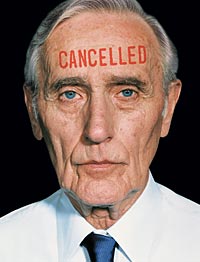Why CEOs fall: The causes and consequences of turnover at the top
An exclusive study of the world’s 2,500 largest companies shows CEO succession has increased by 53 percent in just the last six years. The reason: shareholders want returns now.
Jack Welch of GE, Enrico Bondi of Montedison, UBS’s Luqman Arnold, Yoshikazu Hanawa of Nissan, Yoichiro Kaizaki of Bridgestone, and both Ken Lay and Jeff Skilling of Enron were among the 231 chief executive officers of the world’s 2,500 largest publicly traded corporations who left office during 2001. Their departures prompted, in no particular order, effusive eulogies, columns of news, best-selling books, endless speculation, and continuing investigations. And no wonder: CEOs are the emperors of global business, overseeing the working lives of millions of men and women, and guiding hundreds of billions of dollars of shareholders’ capital. With the daily routines and the future well-being of so many people dependent on the leadership of CEOs, we understandably celebrate their successes, rue their mistakes, and pay almost obsessive attention to their fates.
Despite the many well-researched articles about individual chief executive officers, there have been no systematic studies of the impact on CEOs’ careers of the tectonic shifts in global business, such as rising shareholder activism and changing corporate governance. Although the performance of chief executives has been the subject of extensive research, much of that research has focused on performance relative to compensation. Little if anything is available that charts relationships among CEO tenure, CEO demographics, and corporate performance. And nothing compares trends in these areas across geographies or industries.
To bridge this critical knowledge gap, Booz Allen Hamilton recently concluded what we believe to be the most comprehensive study ever done of the careers of global chief executive officers. For the 2,500 publicly traded corporations with the largest market capitalizations in the world on January 1, 2001, we identified all the chief executives who completed their stewardship during 2001 — the departing class of 2001. We analyzed these executives’ entire tenures as CEOs, including not only personal demographic data, such as age at ascension and departure, but also the financial performance of their companies, measured by net income growth and total returns to shareholders. To provide historical context, we also identified and analyzed the departing CEO classes of 1995, 1998, and 2000, focusing on the 2,500 largest companies in each given year.
Our data demonstrates that shareholder activism and changes in corporate governance have transformed the CEO’s world, especially in Europe and North America. For example, from 1995 to 2001:
- Turnover of the CEOs of major corporations increased by 53 percent.
- The number of CEOs departing because of the company’s poor financial performance increased by 130 percent.
- The average tenure of CEOs declined from 9.5 years to 7.3 years.
The premature departure of a CEO — a “retirement” that, however described, is not voluntary, and that in years past befell only the unlucky or ineffective — is no longer an exceptional event, but the rule. Of the CEOs who departed in 1995, 72 percent either died in office or retired, with thanks from their boards, according to a public schedule. In 2001, only 47 percent of corporate chiefs achieved such regular transitions. The “new normal” is an early departure for the CEO, either because of performance or because of a merger. Today’s CEOs are like professional athletes — young people with short, well-compensated careers that continue only as long as they perform at exceptional levels.
In addition, we found significant and surprising differences among geographic regions. In Europe, where corporate chiefs are presumed to be more protected by intimate relationships among senior management, boards, governments, and financial institutions, CEOs are actually most at risk. In the Asia/Pacific region, where such relationships also are presumed to exist, changes in CEO careers and CEO turnover have been minimal.
The transformation in the CEO’s world has profound consequences for everyone in and around business. CEO-driven changes in management behavior affect the rest of us as employees, customers, and shareholders. In Europe and North America, CEO turnover is the bridge between the behavior of the management team and returns to shareholders.
Our findings suggest several behavioral shifts that can help CEOs to survive — for example, they can focus less on extraordinary gains in shareholder value during their first two years in office and more on organizational and strategic reforms that aim at growth that is both strong and steady. The regional differences, too, will likely have a significant effect. As the world’s largest companies increasingly compete on a global scale, we believe the increasing differences in the behavior of CEOs in the major regions will contribute substantially to which companies win in tomorrow’s marketplaces, and which regions enjoy the most growth.
Although our analysis shows that CEO turnover, surprisingly, declined in 2001 from 2000, we believe the long-term trend toward greater accountability and ever-higher CEO turnover, evident across the years studied, will continue. The business environment has fundamentally changed; the implications of the change are only now becoming visible.
The Facts about CEOs
“The King is dead. Long live the King!” identifies, in the world of royalty at least, what we call a “succession event.” A corporate succession event — the departure of one CEO and the ascension of another — begins and ends a chief executive’s term of office. Typically, the end of one tenure and the beginning of another is a single event, as it was, for example, in the transfer of power from Gerald Levin to Richard Parsons at AOL Time Warner Inc. in 2002. However, on occasion, a CEO departs and is replaced by an interim CEO, who subsequently leaves office when a permanent chief is named. We consider this to be two succession events.
In the largest 2,500 companies in the world, the frequency of CEO succession events increased from 6.0 percent per year in 1995 to 11.2 percent per year in 2000. Despite the drop to 9.2 percent in 2001, the frequency of CEO succession last year was still 53 percent higher than in 1995.
Exhibit 1 shows that the trend in the frequency of CEO succession varies significantly across North America, Europe, and Asia/Pacific. To normalize for the differences in succession rates across the regions, we indexed each region to its rate of succession in 1995. Although Europe and North America show similar patterns, the frequency of succession in Europe increased much more — by 139 percent from 1995 to 2001, compared with only 31 percent in North America. Asia/Pacific is remarkably different: In 2001, the frequency of CEO succession was lower than in 1995.

To understand the drivers of these changes in the rate of CEO succession, we analyzed individual succession events, and assigned each succession to one of three categories:
- Merger-driven, in which the CEO’s job was eliminated, typically because the chief of the other company in the merger assumed responsibility for the combined enterprise.
- Performance-related, where the CEO was asked to leave by the board of directors; where there was significant speculation in the business press that performance was the driver of the change; or where the CEO cited job stress as the reason for his or her resignation.
- Regular transition, in which the CEO retired on a long-planned schedule, took a better position elsewhere, stepped down for serious health reasons, or died in office.
We classified as “regular” any succession that was consistent with a long-planned schedule, or involved the CEO’s acceptance of a better position elsewhere, illness, or death. We classified as “performance-related” any departure that was reportedly initiated by the board, or resulted from poor financial or managerial performance (including scandals), or was attributed to “personal reasons.” To cite one example, when Jeffrey Skilling left the CEO’s office at Enron last year, he cited unspecified personal issues as the reason for his departure; we interpreted his departure as performance-related. Although this approach is necessarily subjective, in the next section, we’ll present evidence that the departures we classified as “performance-related” are in fact correlated with poor financial performance.
On average, combining data from 1995, 1998, 2000, and 2001, we see that 50 percent of the CEO successions are regular transitions, 25 percent are merger-driven, and 25 percent are performance-related. However, across our total sample, the mix of reasons for the CEO’s departure has changed over time (see Exhibit 2). The figures represent the percentage of the 2,500 companies whose CEO departed for that reason in a year. For example, in 2001, 9.2 percent of the CEOs among the 2,500 largest companies departed — 4.4 percent in regular transitions, 2.5 percent because of mergers, and 2.3 percent for performance-related reasons. From 1995 through 2001, the chart shows, the rate of regular transitions has remained relatively constant. The increased total rate of CEO succession over the years studied has been driven almost entirely by the tripling in the rate of merger-linked departures and the 130 percent increase in performance-related transitions.

One of our most surprising findings is that the proportion of CEOs departing for performance reasons is higher in Europe than in North America (see Exhibit 3). Across the years studied, European CEOs have the lowest likelihood of achieving a regular transition.

In our remaining analyses, we exclude merger-driven successions, except where specifically noted. Mergers have a widely studied logic that is only partly related to the actions of the CEO of the target; a takeover also inflates short-term returns to shareholders. In addition, we exclude CEOs who served on an interim basis while their boards searched for a “permanent” replacement. Focusing instead only on CEOs who are expected to serve a full term, and who depart in either a regular or a performance-driven transition, provides the best understanding of the changing CEO career path and the growing importance of financial performance to that career path.
The Performance Principle
For each year studied, we identified the 2,500 largest companies and then measured each company’s financial performance during the tenure of a CEO in two ways. First, we calculated total returns to shareholders, including both stock price appreciation and dividends. Since the returns on the stock market fluctuate so much over time — potentially causing anomalies in the assessment of any individual’s performance at the point of his or her departure — we normalized CEO performance by subtracting the returns in the region during the CEO’s tenure (as measured by Morgan Stanley’s regional stock indices) from the returns in the CEO’s company. Hence, a total shareholder return of 1 percent in a given year means that the returns to shareholders of the CEO’s company that year were one percentage point higher than the returns on a basket of all publicly traded stocks in the region.
The second way we measured each company’s financial performance was by calculating the growth rate in net income during the CEO’s tenure. Recognizing the significant accounting differences between regions and the discrepancies in industry growth rates, we adjusted net income growth by both region and industry, using the 23 Industry Groups of S&P/Morgan Stanley’s Global Industry Classification Standard.
In each succession year studied, returns to shareholders during the tenure of the departing CEOs were significantly higher from companies whose CEOs left in a regular transition than from companies whose CEOs resigned for performance-related reasons (see Exhibit 4). Across all the years studied and all regions, regularly departing CEOs beat the market by 1.3 percent, whereas those resigning for performance reasons underperformed the market by 8.3 percent.

Since Exhibit 4 reflects performance throughout a CEO’s entire tenure — good years and bad — it understates the performance shortfall that triggers the premature departure of a chief. Departing CEOs always underperformed the total market during their last year in office. However, companies whose CEOs achieved a normal transition outperformed companies whose CEOs left because of performance by 25.7 percentage points (see Exhibit 5).

Regional differences become apparent when the performance of departing CEOs is analyzed. In both Europe and North America, companies whose CEOs had regular transitions performed significantly better than companies from which the CEO’s departure was performance-related. In Asia/Pacific, however, there was no difference between the performance of companies with regularly transitioning CEOs and those whose CEOs left for performance reasons (see Exhibit 6).
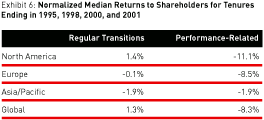
These findings don’t imply that “performance-related” departures of CEOs in Asia/Pacific aren’t related to performance. They reflect the traditional emphasis, primarily in Japan, of net income growth over shareholder returns. Indeed, when we analyzed corporate net income growth across the three regions and viewed it through the lens of CEO turnover, we could see the unmistakable importance net income growth plays in Japanese companies relative to firms elsewhere (see Exhibit 7).
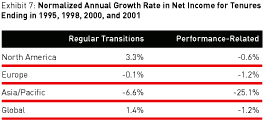
There is also a correlation between corporate performance and the chief’s role in the firm. An executive holding the titles of both CEO and chairman of the board is more likely to deliver greater returns to shareholders and higher net income growth. What’s more, a multiple-titled executive is likelier to have a longer tenure and a regular transition (see Exhibit 8). Our hypothesis is that the correlation seen in the aggregated data stems from those occasions when boards of directors give an incoming executive the title of chief executive, but reserve the board chairmanship until the executive demonstrates success. In these situations, the executives who are successful will gain the chairman title, whereas those who are less successful will end their careers as CEO but not chairman.

Performance pressures contributed not only to the rate of CEO turnover, but to changes in CEO longevity as well. Across our four departing CEO classes, the average tenure of exiting CEOs declined continually, from 9.5 years in 1995 to 7.3 years in 2001 (see Exhibit 9).

The principal driver of the overall decline in tenure has been the 35 percent reduction (from 7 years to 4.6 years) in the careers of CEOs who ultimately leave for performance-related reasons. By 2001, a CEO who departed because of performance had a tenure only about half as long as that of a CEO who made a regular transition (see Exhibit 10).

Tenure of CEOs is significantly different in the three regions. Tenure is shortest in Europe — only 6.5 years — both because the proportion of performance-related actions is highest in Europe and because poorly performing European CEOs are removed so quickly. North American CEOs enjoy the longest tenure, especially if they make a regular transition. Job performance has the most impact on CEO tenure in North America, where the average tenure ending in a regular transition is more than twice the average tenure ending in a performance-related transition. Job performance has the smallest impact on tenure in Asia/Pacific — the region with the shortest tenure in regular transitions and the longest tenure in performance-related transitions (see Exhibit 11).

Why is the tenure of Asia/Pacific CEOs so short, especially among those who make regular transitions? Our hypothesis is that it’s because Asia/Pacific CEOs, particularly those in Japan, are a decade older than their European and North American counterparts when they assume CEO responsibilities (see Exhibit 12). In fact, only in Asia does the mythical image of the chief executive — a gray-haired, gray-suited, male eminence — retain validity. Although they are still overwhelmingly male, CEOs in the West rise to office, on average, below the age of 50. In demographic terms, today’s Western CEO is a child of the ’60s. And, despite slight upticks in Europe and North America in 2001, the ages of CEOs at the time of ascension is declining. Although this means they have less experience than their counterparts at Asian companies, successful Western CEOs now have the advantage of longer time in office.

Industry Differences
Most of the patterns observed over time and across regions are mirrored within each industry sector. However, some differences among industries stand out. In rate of CEO succession, telecommunications services, energy, and information technology were all significantly higher than average. The CEO Safety Index in Exhibit 13 — the proportion of CEO turnover in an industry divided by the proportion of companies in the industry — measures the rate of CEO succession. In telecommunications and energy, merger activity was responsible for the high turnover. Industry volatility leading to performance-related departures drove turnover in information technology. Financial services and utilities had significantly lower rates of CEO turnover, especially during 1995 and 1998, when the favorable financial environment in the United States reduced performance-related succession.
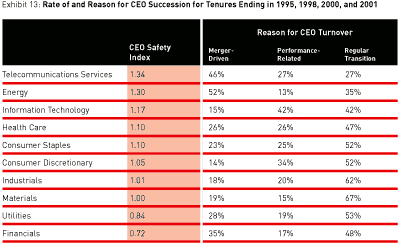
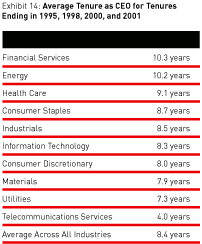
Excluding CEOs who depart following a merger, CEO tenure is greatest in financial services and energy. The four-year tenure of CEOs in telecommunications services is less than half the average tenure of CEOs in all industries (see Exhibit 14).
We believe the exceptionally high turnover rates among CEOs in the information technology and telecommunications industries, triggered by the collapse of the dot-com bubble in the United States, the 3G debacle in Europe, and the global capacity glut in communications, drove the exceptionally high overall turnover of CEOs in 2000. This, in turn, helps explain the otherwise anomalous increase in CEO tenure seen in 2001. If the exceptional turnover in those industries is removed from 2000, then CEO turnover in 2000 drops to almost the level of 2001 — which, of course, is still significantly higher than the earlier years studied.
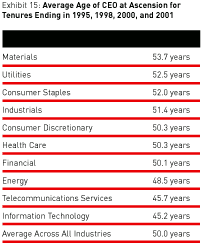 Average ages also differ significantly by industry (see Exhibit 15). CEOs in the information technology and telecommunications services industries are only about 45 years old at ascension, five years younger than the average. In materials, CEOs average almost 54 years old at ascension. Overall, though, regional differences are much larger than industry differences.
Average ages also differ significantly by industry (see Exhibit 15). CEOs in the information technology and telecommunications services industries are only about 45 years old at ascension, five years younger than the average. In materials, CEOs average almost 54 years old at ascension. Overall, though, regional differences are much larger than industry differences.
The New Rules for the CEO
What are the implications of our findings for CEOs — at least for CEOs in Europe and North America, where the game has clearly changed? Put another way, how can CEOs ensure that “Hail to the Chief” doesn’t become hail on the chief?
First and most obviously, CEOs must deliver acceptable and consistent total returns to shareholders. In the U.S. and Europe, the growing democratization of shareholding has clearly placed total shareholder returns higher on the management and board agenda than it was in years past, when net income and return on assets were the measures by which the firm’s managers were judged. In those bygone days, management focused on effective stewardship; the relevant benchmarks were competitors in the same industry. Today, however, shareholders — from individual investors to giant pension funds — are increasingly judging each company against all others; as financial markets become more global, transparent, and accessible, those judgments are being rendered across continents as well. This requires a fundamental change in management behavior and perspective. From the shareholder’s perspective, the effectiveness of a CEO is measured by how much a company’s performance improves (along with its prospects). Management now has little choice but to focus on repeated improvement.
The difference between the net income/return on assets and shareholder return perspectives is most apparent following the departure of a famously successful CEO, such as Percy Barnevik of ABB or Jack Welch of GE. Once raised by a successful CEO, shareholder expectations remain sky-high. Even if the successor CEO delivers very good net income growth and an attractive return on assets, the company’s failure to meet inflated expectations will depress share price. As our analysis shows, continued failure to exceed the market’s average returns is the surest path to a CEO’s early departure. Thus, the new truism in business: The job of top management is to improve a company’s performance (and raise expectations of future performance). CEOs in Europe and North America who don’t embrace that definition of their job won’t have a job for long.
The second rule for contemporary CEOs: Manage against the major risk factors. Driving growth means identifying and serving customer needs in ways dramatically better than those that preceded. That often requires a company to take sizeable bets. These can be managed — by focusing on the core businesses even as new businesses are being developed, by applying a portfolio approach to strategic investments, and by creating sensing networks that enable the company to rapidly see and adapt to changes in the markets it serves. Such risk management mechanisms are essential; downside performance, our analysis shows, drives turnover more than a lack of upside performance. Remarkably, in Europe and North America, CEOs who ultimately departed for performance-related reasons actually performed better than their peers in the first half of their tenures. It was the significant decline in their performance during the second half that was responsible for their departure. Steady, good performance results in greater CEO longevity than a spurt of excellent performance followed by a decline (see Exhibit 16).

It also appears that steady, good performance is better for shareholders. There is a chicken-and-egg question here — does good performance lead to longevity, or does longevity lead to good performance? — but the general conclusion is inescapable: Longer CEO tenure correlates with greater total shareholder returns (see Exhibit 17).
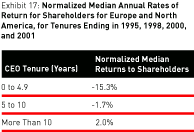
Longer-tenure CEOs perform better for their shareholders in both halves of their tenure (see Exhibit 18). Dividing returns by tenure highlights a very interesting finding: Both long- and short-tenure CEOs underperform the stock market during the second half of their tenure. Long-tenure CEOs start strong and then fulfill the market’s expectations. Short-lived CEOs end with very poor performance (although the positive mean returns imply that some start very strong).
The third rule for the CEO: Define and achieve your change agenda quickly. The declining tenure for CEOs, especially CEOs with performance-related departures, underscores the need for speed; in 2000 and 2001 the average tenure for CEOs with performance-related departures was only 4.7 years, as clear a sign as any that shareholders expect action quickly. The findings in Exhibit 18 also are consistent with our experience in consulting for major corporations: Most CEOs are much more effective in driving change during the first part of their tenure. Sustaining beneficial change and persistently exceeding the market’s expectations is the hallmark of the most successful CEOs.

Globalization and the CEO
Throughout our analysis, we’ve highlighted significant differences in the pattern of CEO careers in Europe, North America, and the Asia/Pacific region. What are the likely implications of the differences?
Europe is the most aggressive region in replacing CEOs whose companies aren’t performing well; it has the highest proportion of both performance-related and merger-driven turnover, the fastest rate of growth in CEO turnover, and the shortest average CEO tenure. Our hypothesis is that the growing importance of shareholder returns in a global economy, marked by increasing competition for capital, suppliers, customers, and talent, is accelerating the pace of transformation in large European businesses. The insistent process of natural selection in Europe, in which CEOs unsuccessful in delivering superior returns to shareholders are rapidly replaced, should result in an even more capable leadership of major European companies, improving Europe’s competitiveness in the global economy.
Yet, despite the growing importance of a broader set of shareholders, our hypothesis is that all stakeholders will continue to be important in Europe. That balance helps European CEOs to avoid the massive restructurings that have created immediate shareholder value in North America, but have resulted in short CEO tenures because the change wasn’t sustained. The challenge for European CEOs will be to find the balance between shareholders interested in rapid improvement and stakeholders who are more resistant to change. Finding such a balance can result in sustained growth in revenue, income, and shareholder returns, as well as harmonious relationships among the company, its employees, and its community.
Although North America also has seen increasing CEO turnover, the continent is unique in its high proportion of long-serving CEOs. Among CEOs ending their tenure in one of the four years we studied, 17 percent of North American CEOs had been in office for 15 or more years, in contrast to 6 percent in Europe and 4 percent in Asia/Pacific. This group of long-serving North American CEOs — among them Jack Welch of GE, Chuck Knight of Emerson, Ken Iverson of Nucor, Herb Kelleher of Southwest Airlines, Peter Lewis of Progressive Insurance, Orin Smith of Engelhard, and Hugh McColl of NationsBank — created enormous value for shareholders, and played an essential role in transforming their industries.
Our hypothesis is that the idea of the long-serving CEO is deeply ingrained in the U.S. business culture. In part, this may be the result of an economic environment that has long favored entrepreneurialism; many of America’s largest companies are still led by their founders. Entrepreneurial cultures also adhere to the presumption that individuals can be responsible for the success of large organizations — another factor undergirding the prevalence of long-serving CEOs in the U.S.
Although North America will continue to benefit from successful CEOs of long tenure, we expect that turnover will increase until it is more akin to European rates. Not only will boards terminate CEOs of underperforming companies more quickly, but long-serving CEOs who haven’t created significant value for shareholders lately, however successful they were early in their tenure, will face increasing pressure to retire early.
The big question mark is Japan, which is responsible for the very different pattern we’ve observed in Asia/Pacific: no change in the rate of CEO turnover from 1995 to 2001; the lowest proportions of merger-driven and performance-related departures; the smallest impact of CEO performance upon tenure; the oldest CEOs at ascension; and the least orientation toward shareholder returns. The revival of Nissan under the leadership of Carlos Ghosn — a non-Japanese chief executive — has kindled a debate in that nation about the desirability and feasibility of such aggressive transformations. Only as that debate continues will we know whether Japan will soon adopt elements of the Western management model.
However the Asia/Pacific region grapples with the change, our hypothesis is that CEO turnover will continue to increase globally, sustaining the trend we have seen from 1995 through 2001. There are four reasons:
- CEO turnover is a means — perhaps the means — to link management to the creation of shareholder value. CEOs who depart for performance-related reasons generate poor returns for shareholders.
- All CEOs perform better during the first half of their tenure. Since chief executives deliver significantly higher returns for shareholders during the first half of their time in office, we anticipate more pressure from shareholders and boards for more frequent changes.
- The public is increasingly demanding that CEOs bear responsibility for their company’s problems. The concern in the United States and Europe that CEOs are violating public trust, as symbolized by Enron, is spawning changes in corporate governance that will increase CEO turnover.
- More experienced CEOs are available to run companies. The combination of shorter tenures and the younger age of CEOs at ascension creates a pool of experienced former CEOs available for boards who want to replace a company leader. Many retired CEOs who are still in their 50s — including those who departed following a merger, those who performed well for shareholders during much of their tenure, and those who were beset by bad luck — remain credible candidates to be CEOs of other public companies. When supply and demand coincide, markets are created.
In Homer’s Iliad, Achilles is offered the choice between a short, glorious life and a long, unremarkable one. Today’s chief executives face a starker world. They have no choice: They must be remarkable. Otherwise, their professional lives will be short. ![]()
Also contributing to this article was Julien Beresford (beresford_julien@bah.com), president of The Beresford Group, a research company based in Westport, Conn.
Reprint No. 02305
|
Methodology |
|
This study required the identification of the world’s 2,500 largest public companies based on their market capitalization on January 1. We used market capitalization rather than revenues because of the different ways financial companies recognize and account for revenues. The Compustat/Global Vantage database of public companies provided a ranking of all publicly traded companies on December 31 of 1994, 1997, 1999, and 2000. To identify the companies among the top 2,500 in each year that had experienced a chief executive succession, we initially used the LexisNexis electronic data files of the Directory of Corporate Affiliations (which we compared for the years before and after the year in question to see whether a change in the CEO had occurred) for CEO changes in the first three time periods (1995, 1998, and 2000). For changes in 2001, we used a file of executive changes provided by idEXEC (a global business-to-business contact database of executive decision makers). We also used a variety of printed and electronic sources, including Corporate Yellow Book and Financial Yellow Book (both published by Leadership Directories, N.Y.); Forbes; Fortune; the Financial Times; the Wall Street Journal; and several Web sites containing information on CEO changes (www.ceogo.com, www.executiveselect.com, and www.chiefexecutive.net). Additionally, we conducted electronic searches of the Dow Jones Interactive (DJI) database in the selected years for any announcements of retirements or new appointments of CEOs, presidents, managing directors, and chairmen; results of this search were compared to the list of the top 2,500 companies. For firms that had been acquired or merged in any of the subject years, we used the Thomson Financial Mergers & Acquisitions database. Each company that appeared to have experienced a CEO change was then investigated for confirmation that a change had occurred in the relevant year and for identification of the outgoing executive: title(s) upon succession, starting and ending dates of tenure as chief executive, age, and the true reason for the succession event. Company-provided information was acceptable for each of these data elements except the reason for the succession; an outside press report was frequently necessary to learn the true reason for an executive’s departure (because company press releases often obscure the underlying reason for an executive’s departure). We used a variety of online sources to collect this information on each CEO tenure, including company Web sites, the DJI database, Hoover’s Online, Northern Light, and proxy statements available on the U.S. Securities and Exchange Commission’s (SEC’s) EDGAR database (for U.S.-traded securities). In some cases, when the online sources were unproductive, we contacted the individual companies by e-mail and telephone to confirm the tenure information. We enlisted the assistance of Booz Allen Hamilton offices worldwide as part of this effort to contact companies directly. We then calculated average growth rates (AGRs for total tenure, first half, and second half) for three types of financial and shareholder information for each executive’s tenure: net income, net income as a percentage of book value, and total shareholder return (TSR, including the reinvestment of dividends, if any). For interim CEOs, we also obtained the financial information for the prior periods, if any, that they served as CEO. To enable meaningful cross-industry comparisons, we calculated the same income data information for the relevant industry and region (e.g., automobiles and components in North America, Europe, Asia/Pacific, South America, or Africa) using the S&P/Morgan Stanley Global Industry Classification Standard (GICS). The revenue, net income, and book value data was provided by S&P (Custom Projects); quarterly data was provided for North American–traded securities; and annual data was provided for other firms. TSR and market value data was provided by Datastream. Regionally adjusted AGRs were calculated by subtracting the Morgan Stanley Capital International (MSCI) regional shareholder return indices from the company’s performance during the periods in question. |
| Authors
Chuck Lucier, chuck@chucklucier.com Chuck Lucier is senior vice president emeritus of Booz Allen Hamilton. He is currently writing a book and consulting on strategy and knowledge issues with selected clients. For Mr. Lucier’s latest publications, see www.chucklucier.com. Eric Spiegel, spiegel_eric@bah.com Eric Spiegel is a senior vice president with Booz Allen Hamilton in Tokyo and the managing director of the firm’s international businesses outside the U.S. and Europe. His work focuses on strategy, organization, and operations improvement, primarily for large energy and industrial companies. Rob Schuyt, schuyt_rob@bah.com Rob Schuyt is a vice president with Booz Allen Hamilton in Amsterdam. His expertise is in developing growth, innovation strategies, and performance improvement for clients in the media and communications industries. |


